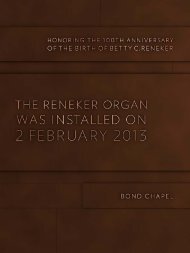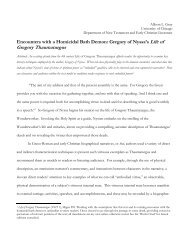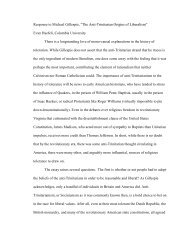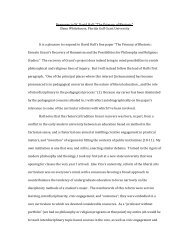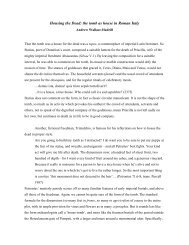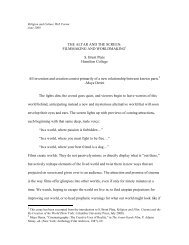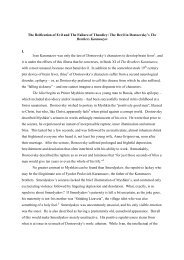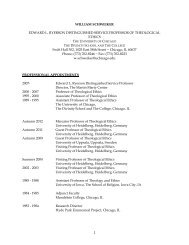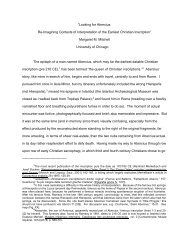*Criterion Winter 02-4.16 - Divinity School - University of Chicago
*Criterion Winter 02-4.16 - Divinity School - University of Chicago
*Criterion Winter 02-4.16 - Divinity School - University of Chicago
Create successful ePaper yourself
Turn your PDF publications into a flip-book with our unique Google optimized e-Paper software.
Religion and Science, Faith and Reason<br />
Continued from page 37<br />
But even if we could, should we even try to bridge the gap?<br />
Perhaps it is better to leave the two sides as they are, uneasily<br />
regarding one another across the chasm. Perhaps it is better<br />
for each side to have the other around in order to limit its<br />
own certainty and self-satisfaction. In a world in which conspiracies<br />
do happen, it is probably good for those <strong>of</strong> us who<br />
see a world <strong>of</strong> reason and light to have others around who<br />
see a world <strong>of</strong> dark conspiracies to remind us that we may be<br />
wrong, just as it is good for those with a conspiratorial worldview<br />
to have the rest <strong>of</strong> us around to remind them that their<br />
view might be mere paranoia. In the complex social world in<br />
which we live, it is probably good to have both political liberals<br />
and conservatives to challenge each other’s most basic<br />
assumptions, and to prevent either from becoming too lazy<br />
and complacent in their views. Similarly, it is probably good<br />
for both those who subscribe to a secular scientific worldview<br />
and for theists to have one another around to remind themselves<br />
that, for all they know, the world might be a very<br />
different place than they imagine. ❑<br />
38 WINTER 20<strong>02</strong><br />
ENDNOTES<br />
1. Ian Barbour, When Science Meets Religion (San Francisco:<br />
HarperSanFrancisco, 2000), 23.<br />
2. Barbour, 2.<br />
3. References to the Pensées are by section number, which I will give<br />
in the text. I am quoting from the translation <strong>of</strong> A. J. Krailsheimer<br />
(Harmondsworth, England: Penguin Books, 1966), who follows the<br />
ordering established by Louis Lafuma. The reader should be warned<br />
that not all editions <strong>of</strong> the Pensées, in French or in English, follow<br />
this ordering.<br />
4. The text <strong>of</strong> the law is given in Michael Ruse, ed., But Is It Science?<br />
(Buffalo: Prometheus Books, 1988), 283.<br />
5. Ruse, 318.<br />
6. Ruse, 301.<br />
7. Ruse, 320.<br />
Secret Epiphanies<br />
Continued from page 25<br />
God from God and Light from Light,<br />
guarding all creation,<br />
one with us in flesh and blood,<br />
calls to every nation<br />
There among you is one you do not know.<br />
Then let patience be your guide,<br />
walk in ways <strong>of</strong> justice;<br />
show each other at all times<br />
every kind <strong>of</strong> goodness.<br />
There among you is one you do not know.<br />
Now be carefree, full <strong>of</strong> joy:<br />
God, who knows and calls us,<br />
brushes by us every day,<br />
makes a home among us.<br />
There among you is one you do not know.<br />
The Bond Chapel choir, directed by Peder Jothen, sung this<br />
hymn at the conclusion <strong>of</strong> Pr<strong>of</strong>essor Mitchell’s sermon.<br />
Hymn by Huub Oosterhuis and Bernard Huijbers, from John 1:26,<br />
translated by Tony Barr. © 1967, 1996, Gooi en Sticht, bv., Baarn, the<br />
Netherlands. All rights reserved. Printed with permission from Oregon<br />
Catholic Press Publications.



